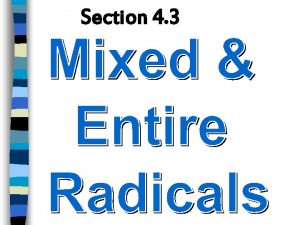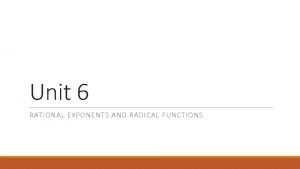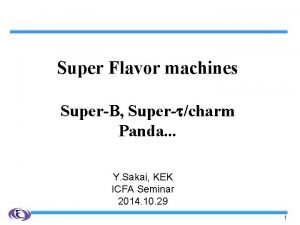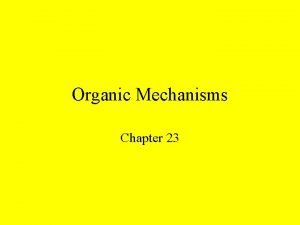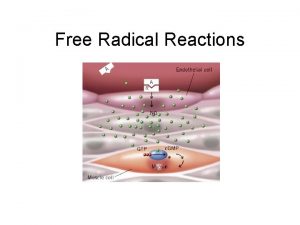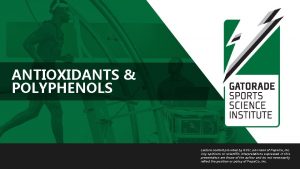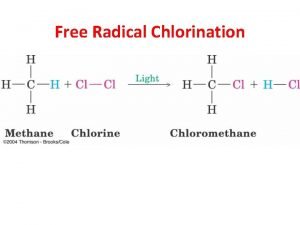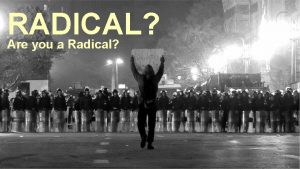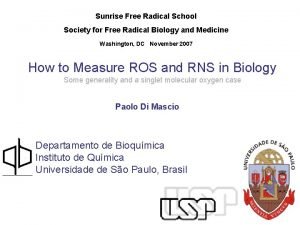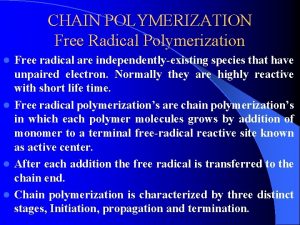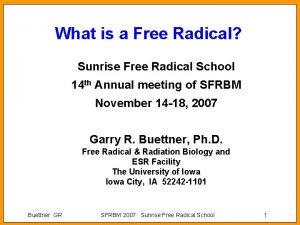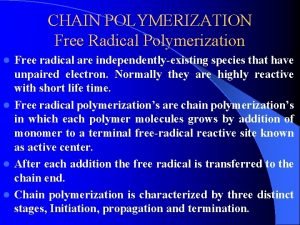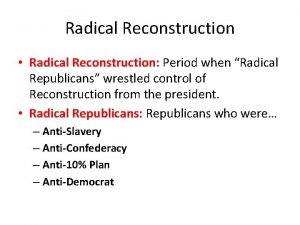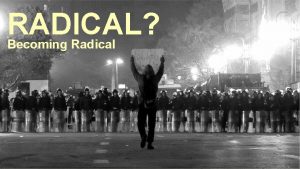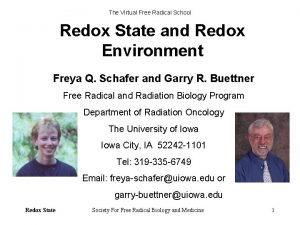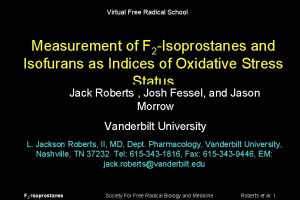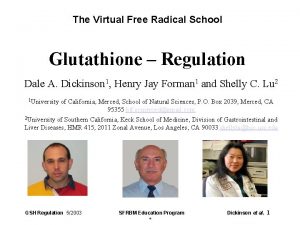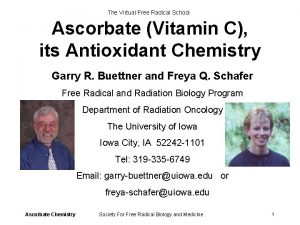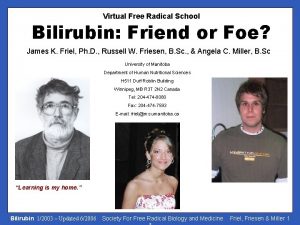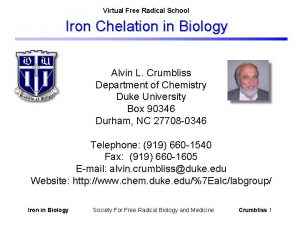The Virtual Free Radical School Free Radical Production

















- Slides: 17

The Virtual Free Radical School Free Radical Production During Ethanol Metabolism Lester A. Reinke, Ph. D. Department of Pharmaceutical Sciences College of Pharmacy University of Oklahoma Health Sciences Center Oklahoma City, OK 73190 Tel: (405) 271 -6593, Ext. 47246 E-Mail: lester-reinke@ouhsc. edu Ethanol Metabolism Society For Free Radical Biology and Medicine Reinke 1

Ethanol Metabolism n Ethanol is oxidized to acetaldehyde through several enzymatic pathways: n Alcohol dehydrogenase n n Catalase n n CH 3 CH 2 OH + H 2 O 2 → CH 3 CHO + 2 H 2 O Cytochrome P-450 n n n CH 3 CH 2 OH + NAD+ → CH 3 CHO + NADH + H+ The “Microsomal Ethanol Oxidizing System” (MEOS) CH 3 CH 2 OH + NADPH + H+ + O 2 → CH 3 CHO + 2 H 2 O + NADP+ And through a non-enzymatic free radical pathway: Ethanol Metabolism Society For Free Radical Biology and Medicine Reinke 2

Free Radical Metabolite of Ethanol n Strong oxidizing intermediates such as the hydroxyl radical can abstract a hydrogen atom from ethanol, preferentially producing the 1 -hydroxyethyl radical (also called the α-hydroxyethyl radical) CH 3 CH 2 OH + • OH → CH 3 C • HOH + H 2 O n Hypervalent iron complexes may also catalyze this reaction without the apparent involvement of • OH 1, 2. 1 Reinke LA, Rau JM and Mc. Cay (1994), Free Rad. Biol. Med. 16: 485 -492. 2 Welch KD, Davis Z and Aust SD (2002), Arch. Biochem. Biophys. 397: 360 -369. And Qian SY, Buettner GR. (1999) Free Radic Biol Med, 26: 14471456. Ethanol Metabolism Society For Free Radical Biology and Medicine Reinke 3

Reactions of the Hydroxyethyl Radical n n Hydroxyethyl radicals may react with oxygen to form a peroxy radical intermediate, which can then rearrange to release acetaldehyde and superoxide. CH 3 C • HOH + O 2 → CH 3 C(OO • )HOH → CH 3 CHO + O 2 • - + H+ Hydroxyethyl radicals can also react with proteins to produce antigenic adducts 1 or induce the mitochondrial permeability transition 2. 1 Clot P, Bellomo G, Tabone M, Arico S and Albano E (1995), Gastroenterology 108: 201 -207. 2 Sakurai K, Stoyanovsky DA, Fujimoto Y and Cederbaum AI (2000), Free Rad. Biol. Med. 28: 273 -280. Ethanol Metabolism Society For Free Radical Biology and Medicine Reinke 4

Hydroxyethyl Radical Formation in Liver Microsomes n Spin trapping experiments have demonstrated that hydroxyethyl radical formation by liver microsomes requires a source of reactive oxygen intermediates 1 -4. 1 Albano E, Tomasi A, Goria-Gatti L and Dianzani MU (1988), Chem. -Biol. Interact. 65: 223 -234. 2 Reinke LA, Rau JM and Mc. Cay PB (1990), Free Rad. Res. 9: 205 -211. 3 Knecht KT, Thurman RG and Mason RP (1993). Arch. Biochem. Biophys. 303: 339 -348. 4 Rashba-Step J, Turro NJ and Cederbaum AI (1993), Arch. Biochem. Biophys. 300: 401 -408. Ethanol Metabolism A. Rat liver microsomes + ethanol, POBN, & NADPH. B. As A, but + catalase C. As A, but with 1 -13 Cethanol. The 12 -line EPR spectrum identifies the 1 -hydroxyethyl radical. Society For Free Radical Biology and Medicine Reinke 5

Rates of Microsomal Hydroxyethyl Radical Formation are Increased by Ethanol Feeding n n Prior ethanol feeding increases rates of hydroxyethyl radical formation by liver microsomes 1 -3. The ethanol-inducible cytochrome P-450 2 E 1 (CYP 2 E 1) is somewhat uncoupled, and produces substantial amounts of superoxide and hydrogen peroxide 4. 1 Reinke LA, Lai EK, Du. Bose CM and Mc. Cay PB (1987), PNAS 84: 9223 -9227. 2 Albano E, Tomasi A, Goria-Gatti L and Dianzani MU (1988), Chem. -Biol. Interact. 65: 223 -234. 3 Rashba-Step J, Turro NJ and Cederbaum AI (1993), Arch. Biochem. Biophys. 300: 401 -408. 4 Eksktrom G, and Ingelman-Sundberg M (1989), Biochem. Pharmacol. 38: 1313 -1319. Ethanol Metabolism Society For Free Radical Biology and Medicine Reinke 6

Hydroxyethyl Radical Formation in vivo n n Spin trapping experiments have demonstrated that hydroxyethyl radicals are formed in mice and rats 1, 2 Radicals of endogenous compounds can also be detected following acute alcohol administration 1, 2. 1 Knecht KT, Bradford BU, Mason RP and Thurman (1990), Mol. Pharmacol. 38: 26 -30. 2 Moore DM, Reinke LA and Mc. Cay PB (1995), Mol. Pharmacol. 47: 1224 -1230. Ethanol Metabolism A. Bile sample from chow-fed rat given POBN only. B. Bile sample from rat in A, but after injecting 1 -13 C-ethanol Society For Free Radical Biology and Medicine Reinke 7

Alcohol-Initiated Radicals of Endogenous Compounds n n Spin trapping experiments with a deuterated derivative of PBN demonstrated that two types of radicals could be formed from endogenous compounds in liver following a large dose of ethanol 1: R-C • H 2 RO • These radicals are likely intermediates of lipid peroxidation initiated by large doses of ethanol 2. 1 Reinke LA, Kotake Y, Mc. Cay PB and Janzen EG (1991), Free Rad. Biol. Med. 11: 31 -39. 2 Di. Luzio NR and Hartman AD (1967), Fed. Proc. 26: 1436 -1442. Ethanol Metabolism Society For Free Radical Biology and Medicine Reinke 8

Radicals Associated with Chronic Ethanol Consumption n n Radicals likely formed from liver lipids of ethanol-fed rats were first detected in vivo in spin trapping experiments with a trimethoxy derivative of PBN 1. High levels of dietary fat (as corn oil) given with alcohol intensifies: n n n Liver injury (steatosis) Cytochrome P-450 induction Lipid radical formation 1 Reinke Ethanol Metabolism LA, Lai EK, Du. Bose CM and Mc. Cay (1987), PNAS 84: 9223 -9227. Society For Free Radical Biology and Medicine Reinke 9

Enhanced Radical Formation In Vivo Following Chronic Alcohol Administration n Chronic alcohol administration to rats increased in vivo formation of hydroxyethyl and lipid radicals, and caused consistent detection of ascorbate radicals in bile 1. 1 Reinke LA, Moore DR and Mc. Cay PB (1997), Alcohol. Clin. Exp. Res. 21: 642 -646. Ethanol Metabolism A. Bile sample from ethanol-fed rat, given POBN only. The six-line spectrum is likely from lipid radicals, with the central doublet from ascorbate radicals. B. Bile sample from rat in A, but after injection of 1 -13 C-ethanol. Society For Free Radical Biology and Medicine Reinke 10

Role of Polyunsaturated Fat n n n Alcohol feeding with saturated fats causes negligible liver injury. Alcohol feeding with corn oil or fish oil produces liver injury that increases with the unsaturated fat content of the diet 1. Feeding alcohol with fish oil, but not with saturated fat, also increases lipid radical formation 2. Free radicals associated with alcohol feeding persisted for at least 24 h following removal of alcohol from the diet 2. 1 Nanji AA, Griniuviene B, Sadrzadeh SMG, Levitsky S and Mc. Cully JD (1995), J. Lipid Res. 36: 736 -744. 2 Reinke 335. Ethanol Metabolism LA, Moore DR and Nanji AA (2000), Alcohol. Clin. Exp. Res. 24: 332 - Society For Free Radical Biology and Medicine Reinke 11

Potential Involvement of Kupffer Cells n n n Inhibition of Kupffer cells with gadolinium chloride decreased free radical formation and liver injury following chronic alcohol treatment of rats 1. When alcohol-fed rats were given a small dose of lipopolysaccharide, hydroxyethyl radical formation was stimulated 2. Mice deficient in TNFα receptors were resistant to alcohol-induced liver injury 3. 1 Knecht KT, Adachi Y, Bradford BU, Iimuro Y, Kadiiska M, Quh-Hui X and Thurman RG (1995), Mol. Pharmacol. 47: 1028 -1034. 2 Chamulitrat W, Carnal J, Reed NM and Spitzer JJ (1998), Am. J. Physiol. 274: G 653 -G 661. 3 Yin M, Wheeler MD, Kono H, Bradford BU, Gallucci RM, Luster, MI and Thurman RG (1999), Gastroenterology 117: 942 -952. Ethanol Metabolism Society For Free Radical Biology and Medicine Reinke 12

Potential Role of NADPH Oxidase n n NADPH oxidase deficient mice (p 47 phox knockout) exhibited less liver injury and lower levels of radicals during alcohol feeding 1. Treatment of rats with the NADPH oxidase inhibitor, diphenyleneiodonium sulfate, decreased free radical formation and liver injury following chronic alcohol treatment 2. 1 Kono H, Rusyn I, Yin M, Babele E, Yamashina S, Dikalova A, Kadiiska MB, Connor HD, Mason RP, Segal BH, Bradford BU, Holland SM and Thurman RG (2000), J. Clin. Invest. 106: 867 -872. 2 Kono H, Rusyn I, Uesugi T, Yamashina S, Connor HD, Dikalova A, Mason RP and Thurman RG (2001), Am. J. Physiol. 280: G 1005 -G 1002. Ethanol Metabolism Society For Free Radical Biology and Medicine Reinke 13

Potential Role of CYP 2 E 1 n n n CYP 2 E 1 inhibitors fed with alcohol decreased liver injury in alcohol-fed rats 1. Levels of CYP 2 E 1 correlated positively with the degree of liver injury in alcohol-fed rats 1. In contrast, CYP 2 E 1 knockout mice exhibited similar liver injury and free radical formation as alcohol-fed wild type mice 2. 1 Morimoto M, Hagbjork AL, Wan YJ, Fu PC, Clot P, Albano E, Ingelman-Sundberg M and French SW (1995), Hepatology 21: 1610 -1617. 2 Kono H, Bradford BU, Yin M, Sulik KK, Koop DR, Peters JM, Gonzalez FJ, Mc. Donald T, Kilaova A, Kadiiska MB, Mason RP and Thurman RG (1999), Am. J. Physiol. 277: G 1259 -G 1267. Ethanol Metabolism Society For Free Radical Biology and Medicine Reinke 14

Liver Mitochondria and Oxidative Stress n Mitochondria have been implicated as a source of alcohol-induced oxidative stress, and as critical targets of alcoholassociated damage 1, 2. 1 Bailey SM and Cunningham CC (2002), Free Rad. Biol. Med. 32: 11 -16. 2 Adachi M and Ishii H (2002), Free Rad. Biol. Med. 32: 487 -491. Ethanol Metabolism Society For Free Radical Biology and Medicine Reinke 15

Summary: Alcohol-Induced Oxidative Stress n Oxidative stress associated with chronic alcohol administration may be initiated by reactive oxygen intermediates that are most likely generated by: n n n NADPH oxidase found in Kupffer cells and other phagocytes Cytochrome P-450 enzymes The mitochondrial electron transport chain Ethanol Metabolism Society For Free Radical Biology and Medicine Reinke 16

Summary: Free Radicals and Alcohol Toxicity n n n Ethanol is metabolized to a free radical intermediate, the 1 -hydroxyethyl radical, in vitro and in vivo. 1 -Hydroxyethyl radical formation seems dependent on formation of reduced oxygen species and iron. The same oxidizing intermediates that form 1 hydroxyethyl radicals from ethanol likely initiate free radical reactions in lipids and/or other endogenous compounds. Ethanol Metabolism Society For Free Radical Biology and Medicine Reinke 17
 Production post production pre production
Production post production pre production Entire radical form
Entire radical form Unit 6 radical functions homework 6 radical equations
Unit 6 radical functions homework 6 radical equations Radical terminology
Radical terminology Virtual production
Virtual production Has virtual functions and accessible non-virtual destructor
Has virtual functions and accessible non-virtual destructor Free radical reaction mechanism
Free radical reaction mechanism Free radical substitution
Free radical substitution Antioxidant free radical
Antioxidant free radical Free radical halogenation
Free radical halogenation Hát kết hợp bộ gõ cơ thể
Hát kết hợp bộ gõ cơ thể Bổ thể
Bổ thể Tỉ lệ cơ thể trẻ em
Tỉ lệ cơ thể trẻ em Chó sói
Chó sói Tư thế worm breton là gì
Tư thế worm breton là gì Alleluia hat len nguoi oi
Alleluia hat len nguoi oi Môn thể thao bắt đầu bằng từ đua
Môn thể thao bắt đầu bằng từ đua

